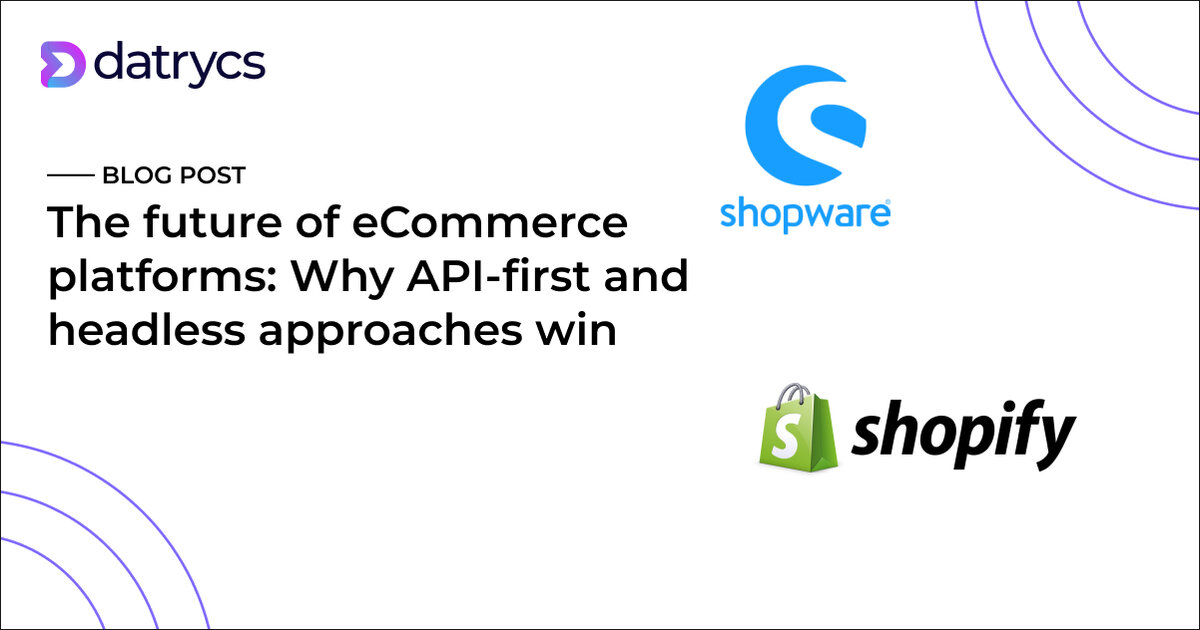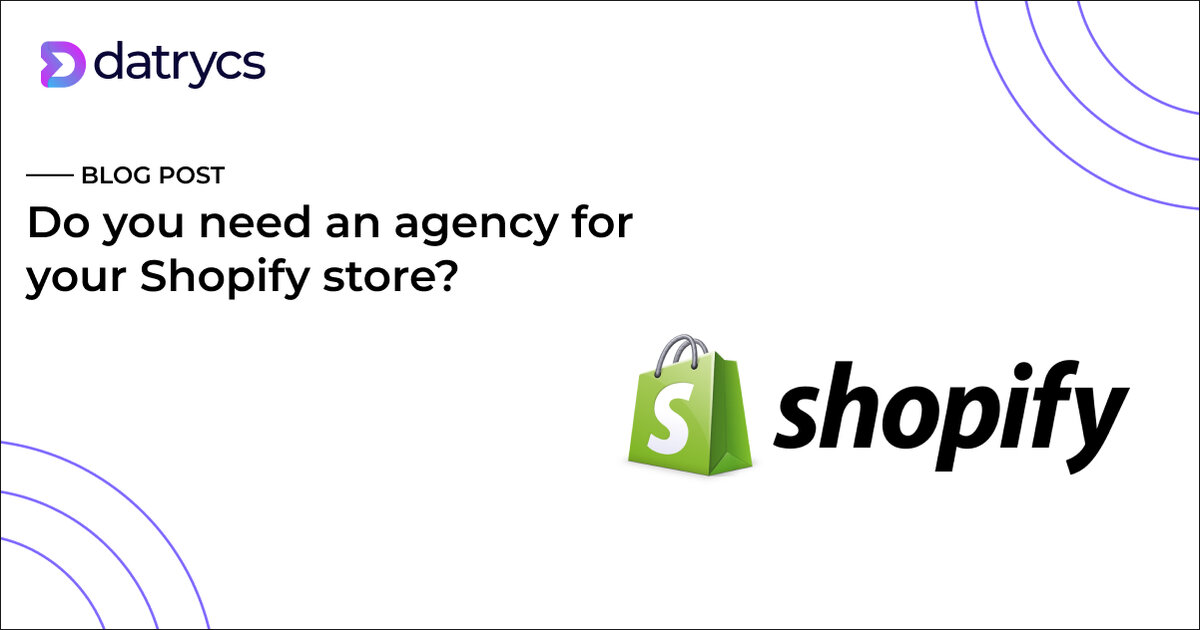The future of eCommerce platforms: Why API-first and headless approaches win
Discover why API-first and headless commerce platforms like Shopify and Shopware lead the future of eCommerce.



Why the future of eCommerce needs a new architecture
Shopping habits have changed. Customers now shop through apps, marketplaces, smart assistants, and even in-store screens, and they expect it all to feel smooth, fast, and tailored to them. These growing expectations are putting pressure on online stores to deliver better experiences across every channel.
The problem? Traditional eCommerce platforms, built as all-in-one systems, aren’t designed for that kind of flexibility. Their tightly connected frontends and backends make it hard to adapt, slow to innovate, and even harder to scale.
That’s why more businesses are moving to API-first and headless commerce. These modern approaches give brands the freedom to build custom experiences, connect with the tools they need, and scale across channels without breaking their setup.
In this article, we’ll break down what API-first and headless really mean, how they compare, and why they’re becoming the go-to architecture for future-ready platforms like Shopware and Shopify.
The current state of eCommerce
The ecommerce industry is experiencing unprecedented growth, with online shopping now a daily habit for millions of global consumers. Recent projections show that global ecommerce sales are on track to reach a staggering $8.1 trillion by 2026, as online retailers like Amazon and Alibaba continue to set new benchmarks for digital commerce. The surge in mobile commerce and the widespread adoption of social media platforms have made it easier than ever for customers to shop online, discover new products, and share their shopping experiences with friends and followers.
Ecommerce platforms are changing fast. Today’s systems use technologies like artificial intelligence and machine learning to offer more personalized shopping experiences and run operations more smoothly. These tools help businesses better understand their customers, manage stock more efficiently, and react faster to changing needs.
The result? Online shopping feels easier, more relevant, and more enjoyable for consumers, and ecommerce continues to grow as one of the most powerful forces in global retail.
What changed in customer expectations
Customers now demand faster delivery, seamless interactions across multiple channels, and hyper-personalized shopping experiences that make them feel understood and valued. According to recent research, 71% of consumers expect personalized experiences, while 76% want businesses to anticipate their needs and preferences.
The rise of voice commerce and the growing influence of social media platforms have further increased the number and complexity of customer interactions. Shoppers expect instant, effective responses to their questions, whether they’re browsing on a website, engaging with a brand on social media, or using a smart speaker to make a purchase. To meet these evolving expectations, ecommerce businesses are turning to AI-powered chatbots, predictive analytics, and data-driven insights. These tools enable brands to deliver hyper-personalized shopping experiences, foster customer loyalty, and ensure that every interaction feels relevant and rewarding, no matter where or how customers choose to shop.
Key market trends that are shaping eCommerce
Social media
Social media platforms have become more than just marketing tools, they’re now integrated sales channels. With 71% of shoppers using platforms like Instagram, TikTok, and Facebook to discover new products, social commerce is blending content, community, and checkout into a single experience. Shoppable posts, live commerce events, and influencer partnerships are turning discovery into conversion. For eCommerce businesses, this means they must rethink the funnel, focusing less on traditional ads and more on building engagement-driven, native shopping experiences within social platforms.
Sustainability as a competitive differentiator
Today’s consumers are increasingly conscious of the environmental impact of their purchases. They’re actively seeking brands that prioritize eco-friendly packaging, carbon-neutral shipping, ethical sourcing, and transparent supply chains. Sustainability is no longer just a “nice to have”, it’s becoming a key driver of brand loyalty and purchasing decisions. Brands that lead in this space are using certifications, life-cycle assessments, and green logistics to not only reduce their footprint but to win over sustainability-minded customers.
Supply chain
With customer expectations for delivery speed and reliability at an all-time high, supply chain optimization has become mission-critical. From real-time inventory visibility to last-mile delivery solutions, eCommerce players are investing heavily in logistics technology. Advanced forecasting tools, warehouse automation, and distributed fulfillment models are enabling faster, more reliable order processing. As global disruptions continue to challenge traditional supply chains, agility and resilience are becoming key competitive advantages.
Subscriptions
Subscription-based models are booming. From curated product boxes to replenishment services, subscriptions offer convenience for customers and predictable revenue for brands. They also open the door to deeper relationships and personalized experiences, as businesses can use customer data to tailor product selections, delivery schedules, and communications. Companies leveraging this model effectively are also using predictive analytics to reduce churn and increase lifetime value.
What is API-first commerce?
An API-first approach means that your eCommerce platform is built from the ground up to expose all core services, products, carts, orders, customer data, through robust, well-documented APIs. API-first platforms can process vast amounts of data, enabling improved decision-making and more efficient operations across your business.
This foundation gives development teams the freedom to build whatever they need, when they need it: whether that’s a custom storefront, a mobile app, a checkout flow embedded in another platform, or an integration with ERP, PIM, or marketing tools. The result? A composable, future-proof commerce infrastructure that can evolve with your business. API-first architecture also streamlines ecommerce operations by enabling real-time data flow and seamless integration across logistics, workforce management, and customer service systems.
What is headless commerce?
Headless commerce refers to the decoupling of the frontend (presentation layer) from the backend (data and logic). This separation allows developers and designers to build completely custom interfaces for web, mobile, POS, or other devices — all connected via APIs to the backend commerce engine. With this approach, brands can deliver a more dynamic and engaging e commerce experience, leveraging the latest technologies to transform online shopping and set new standards for digital storefronts.
Unlike traditional platforms, where the frontend is tightly bound to the backend system and templates, a headless setup allows for unmatched freedom in how your brand appears and functions across touchpoints. This flexibility also enables businesses to create a more personalized experience for customers by tailoring content, offers, and interactions based on data-driven insights.
API-First vs. Headless: A Quick Comparison
Why API-First and headless win in modern eCommerce
Total channel agility
With API-first and headless commerce, you’re not limited to one storefront. You can launch websites, mobile apps, IoT touchpoints, or even sell via marketplaces and smart devices - all from one unified backend. This is especially powerful for omnichannel brands expanding across regions and languages. Online sellers can leverage API-first and headless commerce to quickly adapt to new channels and markets, ensuring they stay competitive and responsive to changing eCommerce trends.
Example: A retailer on Shopify Plus or Shopware 6 can launch multiple localized storefronts, powered by the same backend, each with its own frontend and UX.
Faster performance and better online shopping UX
Modern frontend frameworks like Next.js or Nuxt enable lightning-fast load times, progressive loading, and server-side rendering. These directly improve SEO, conversion rates, and user satisfaction. Enhancements like these also play a crucial role in delivering an outstanding customer experience, which is essential for meeting evolving buyer expectations and building loyalty in today's digital marketplace. Combined with powerful API integrations, you can build lightning-fast sites that never compromise on branding or speed.
Freedom to design personalized shopping experiences
Tired of tweaking outdated templates? With headless, you can build custom product pages, interactive configurators, or localized experiences with no design restrictions. This freedom helps customers feel more connected to your brand and confident in their purchases. UX and brand identity can finally take center stage.
Seamless scalability and Ffexibility
Need to switch payment providers, update your PIM, or add a loyalty program? No problem. API-first systems allow you to swap services and extend functionality without breaking your entire stack. This modularity also enables businesses to control and reduce logistics costs as they scale, helping balance expense management with the need for faster delivery times. That’s the power of modular commerce.
Use cases where headless & API-first shine
- Multi-country rollouts with local currencies, languages, and legal requirements
- Mobile-first commerce, where native or PWA apps require fast, reliable APIs
- B2B platforms with custom pricing, quoting, and bulk ordering logic, supporting online business growth and efficiency
- Content-rich D2C brands using headless CMS for storytelling + shopping, boosting online sales through engaging content and seamless shopping experiences
- Innovation teams experimenting with AR, VR, voice, or kiosk experiences, enabling customers to easily purchase products across emerging channels
A Typical API-First & Headless Stack
Conclusion
API-first and headless commerce are more than technical buzzwords, they’re a mindset shift toward flexibility, innovation, and customer-centric growth. For businesses on platforms like Shopware and Shopify, embracing these architectures now means being ready for tomorrow’s channels, experiences, and expectations. API-first and headless commerce are also shaping the ecommerce market, enabling businesses to scale globally and position themselves as a global leader in digital retail.
The ecommerce market continues to expand rapidly, with a strong compound annual growth rate and an increasing share of retail purchases taking place online each year.
Understanding shopping trends and leveraging new technologies like AR and social media marketing can help businesses drive sales and stay ahead of the competition.
You can contact us today.


